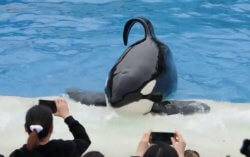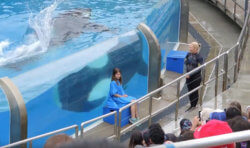Tomorrow, January 1st, 2020, SeaWorld Orlando will replace its “One Ocean” orca show with a new “Orca Encounter” that’s billed as being less showy and more educational. What does this new production mean for the orcas?
The new show has been playing at SeaWorld San Diego for two years, and soon after it opened, it was filmed by “Behind the Thrills,” a website about theme parks and attractions. Parts of the show have been revised since then, largely because many SeaWorld aficionados complained that it was dull compared to the old show. But the video below is still essentially what people will see when it opens in Orlando (and soon, according to SeaWorld, in San Antonio).
Here’s the complete show. It runs just over 25 minutes:
Behind the display tank where the orcas perform, you see a large projection screen picturing an ocean scene with orcas swimming close to shore. It’s designed so that the display tank almost looks connected to the ocean scene. And as the screen shows orcas breaching, spy-hopping and working together in the ocean, the whales in the tank are trained to display similar behaviors.
Discussing the opening in Orlando, SeaWorld’s chief zoological officer Chris Dold writes:
“Guests will learn about killer whales’ role in the ocean ecosystem, behaviors the animals exhibit in the wild, the importance of conservation to their habitat and animal welfare practices at SeaWorld. This educational presentation reflects our company’s mission to inspire people and protect the animals and wild wonders of our world through education, research, animal rescue and conservation.”

But however much the display tank is designed to look like an extension of the ocean background, it’s still nothing more than a small space that the captive whales can circle in just a few seconds. And you can’t help but notice that the second whale to go around the pool has a collapsed dorsal fin – a common condition among captive male orcas. (It’s caused by the fact that they spend most of their lives simply logging on the surface of the water for hours and hours with nothing to keep that dorsal fin from eventually collapsing.)
As for education, the projection screen tells you some facts about orcas around the world, but the orcas in the tank can tell you nothing about life in the ocean. Instead, you can only imagine what it must be like being confined to a barren, claustrophobic tank where their primary form of communication – echolocation – just bounces back at them from the smooth, deadening walls of their prison.
For the orcas on display, nothing has changed.And while SeaWorld touts the new show as being educational and promoting conservation, the one thing the company does not address at all is whether or how their new show has made life any better for the animals themselves.
But it’s all plain to see from the video itself: Very simply, for the orcas on display, nothing has changed. They’re still totally captive in a concrete tank performing tricks in exchange for being fed. It’s a life of utter tedium, as described in this article by Lori Marino, Founder and President of the Whale Sanctuary Project and a leading expert on the brains of whales and dolphins:
“The chronic stress of trying to adapt to such a barren and artificial environment leads to psychological and behavioral abnormalities that eventually wear down the whales’ immune system, resulting in increased infection rates and early death.
“Common behavioral problems include stereotypies – repetitive actions without purpose, e.g. endless circling of the tank, grating the teeth on tank walls and gates. The result of the latter is that 61 percent of captive orcas have dental pathology so that their teeth must be drilled out and then rinsed daily to try to prevent infection.”
For the orcas, then, what’s new is old: an endless repetition of the same daily routine in a small, empty world devoid of the rich experiences and complex relationships they would have known in the ocean that’s portrayed on a two-dimensional screen behind them.

And what of the young people being “educated” by this show? What are they actually learning? Primarily, and regardless of whatever other messages may be being displayed, that it’s OK to treat our fellow animals this way and that they exist for our benefit and entertainment.
Basically, it’s a message of dominance and power. And in particular, when the victims are orcas, it’s a message to young people that we are superior even to the capstone species of the ocean. “You orcas may be the kings and queens of the ocean,” we learn as we leave the stadium, “but when all’s said and done, the fact is you’re the ones who’ll be staying here in the tank.”
More than ever, we need to be offering our children a different kind of education: one that demonstrates a more authentic and humble relationship to our fellow animals; one that would promote an attitude of redress and reconciliation and that would give back to them, in the form of a seaside sanctuary, something of the life that’s been taken from them.